Ivan Čuk
Uvodnik
Tomaž Pavlin
»THE DUTY OF A SOKOL IS TO YET AGAIN STEP INTO THE NATIONAL FRONT LINE«
William A Sands, Wendy L Kimmel, Jeni R McNeal, Sarah L Smith, Gabriella Penitente, Steven Ross Murray, Kimitake Sato, Satoshi Mizuguchi, Michael H Stone
KINEMATIC AND KINETIC TUMBLING TAKE-OFF COMPARISONS OF A SPRING-FLOOR AND AN AIR FLOOR(TM): A PILOT STUDY
Benjamín Bango, Manuel Sillero-Quintana, Ignazio Grande
NEW TOOL TO ASSESS THE FORCE PRODUCTION IN THE SWALLOW
Mario A. Gorosito
RELATIVE STRENGTH REQUIREMENT FOR SWALLOW ELEMENT PROPER EXECUTION: A PREDICTIVE TEST
Petr Hedbávný, Jana Sklenaříková, Dušan Hupka, Miriam Kalichová
BALANCING IN HANDSTAND ON THE FLOOR
Ivan Čuk
Uvodnik
Dear friends, Whole journal.pdf
On October 1st 1863 the first Slovene gymnastics club was established. Our historian Tomaž Pavlin prepared an overview of how Sokol and gymnastics movement developed in Slovenia. I wish we could share historical overviews of all FIG member nations. Up till now, we have published a brief history of the USA, Czech and Slovak gymnastics and I hope that in future there will be more.
It was not only Slovenia that celebrated an important anniversary. FIG celebrated 110 years since the first World Championship (at the time called “International Competition”) was organized by the European Gymnastics Union. Another historical moment was when Kohei Uchimura from Japan took the fourth all around title in a row.
For the last issue in 2013 our fellow researchers prepared six articles which brings us to a total of 20 articles for this year. We too are celebrating an anniversary: this is the fifth year of our existence. How time flies! Journal evaluation for Thomson Reuters Impact Factor has been postponed to the beginning of 2015.
Following the first article about the history of gymnastics in Slovenia, the second article comes from Russia. We are glad that Russian gymnastics scientists and experts are sharing their huge knowledge with us. Olga Rumba is sharing her knowledge on rhythmic gymnastics and gives us practical information about the esthetic part of foot work which could apply to all gymnastics sports (including men’s artistic gymnastics).
The team from USA and UK under William Sands' leadership prepared an interesting case study on kinematic and kinetic tumbling take-off comparisons of a spring-floor and an Air FloorTM. It shows how important it is to research and evaluate any new tools or apparatus used in gymnast's technical or conditional preparation and to be aware of its positive and negative influences.
The fourth and the fifth article are very similar in content but very different in approach. Both the Spanish team Benjamin Bango, Manuel Silliero-Quintana and Ignacio Grande and the Argentinean author Benjamin Gorosito deal with the swallow on rings and they are both trying to help gymnasts to evaluate their readiness for this element.
The last article is by Czech authors Petr Hedbávný, Jana Sklenaříková, Dušan Hupka and Miriam Kalichová. They present a review article about our most common element – handstand. When kids are doing handstand they instinctively correct their position, but for us it is important to recognize and understand the laws of how to maintain the inverted position.
Just to remind you, if you quote the Journal: its abbreviation in the Web of Knowledge is SCI GYMNASTICS J.
I wish you pleasant reading and a lot of inspiration for new research projects and articles.
Tomaž Pavlin
»THE DUTY OF A SOKOL IS TO YET AGAIN STEP INTO THE NATIONAL FRONT LINE«
In Middle Europe, gymnastics have roots in the 19th century and since are witnessing the social inovation and institutionalisation of physical activity and exercises to modern exercising systems named by antique original gymnastics. Gymnastics (various exercising systems such as Ling’s, Jahn’s, Nachtegal’s and Tyrš’s or sokolism) as physical education soon became a significant political, health-eugenic and military instrument in the shaping of national identities and characters in 19 th century. Among middleeuropean Slavs the gymnastic pioneer was Sokol (Falcon) in Prague in 1862 but at the very same year there was also intention to organise gymnastic society in Ljubljana, Slovenia, indepentendly of Prague's events. Because of the contradictions of authorities first Sokol society on the territory of present-day Slovenia was organised in 1863 and became the central Sokol society among Slovenes. In the years before the WW I. Sokol societies spread around Slovenia and united in Union. With the establishing of Yugoslav state after WW I. Slovene Sokols joined with Serbians and Croatians into Yugoslav Sokol. In the paper we descript Sokols story by focusing on some cruical moments in Sokols history. Whole article.pdf
Keywords: Sokol movement, gymnastics, history.
Olga Rumba
IMPROVING THE QUALITY OF THE RHYTHMIC FEMALE GYMNASTS FEET PERFORMANCE BY THE MEANS OF TRADITIONAL CHOREOGRAPHY
In the article we prove empirically that the feet performance quality is the significant constituent part of the sport skills in gymnastics and among the other components it has influence on gymnasts’ success in competitions. Through the survey of the gymnastics specialists we determine the key-points of the female gymnasts’ feet performance quality. According to the received data they are the height of rising to half toe position; the capacity to perform for a long time on one foot and maintain its turnout and the height of half toe position; the capacity to balance for a long time in high turnout half toe position; the degree of toe pointing; feet turnout. We explain the chosen check tests that let estimate the performance degree of all the indexes of the female gymnasts’ feet performance quality. With determining the most effective exercises of traditional choreography we develop the methods of improving the female gymnasts’ feet performance quality. The effectiveness of the developed methods is examined through the educational experiment. Whole article.pdf
Keywords: rhythmic gymnastics, motor skills, culture of movements, quality of feet performance, traditional choreography.
William A Sands, Wendy L Kimmel, Jeni R McNeal, Sarah L Smith, Gabriella Penitente, Steven Ross Murray, Kimitake Sato, Satoshi Mizuguchi, Michael H Stone
KINEMATIC AND KINETIC TUMBLING TAKE-OFF COMPARISONS OF A SPRING-FLOOR AND AN AIR FLOOR(TM): A PILOT STUDY
Tumbling take-offs on floor exercise apparatuses of varying stiffness properties may contribute to apparatus behaviors that lead to increased injury exposure. The purpose of this pilot study was to compare the kinematics, kinetics, and timing performance characteristics of a spring-floor and a spring-floor with an added Air FloorTM. Five male international gymnasts performed a forward handspring to forward somersault and a round off, flic flac, backward somersault on a standard spring-floor and a spring-floor with an Air FloorTM. Performances were measured via high-speed video kinematics (lower extremity joint angles and positions), electromyography of eight lower extremity muscles, mean peak forces on the feet, and timing. Comparisons of spring-floor types, lower extremity joint angles, lower extremity muscle activations, foot forces, and selected durations were determined. The spring floor with Air FloorTM resulted in longer take-off contact durations than spring-floor alone. Dynamic knee angles may indicate an unexpected and potentially injurious motion of the triceps surae musculotendinous structures. This pilot and hypothesis generating study has suggested future research examining dynamic knee position and angle changes, the role of spring-floor vibration and stiffness in take-offs, and take-off muscle activation alignment with the stiffness of the spring-floor. Pragmatically, there appears to be a convergence of evidence indicating that a slower frequency response of the spring floor may assist tumbling performance and reduce stress and strain in the lower extremity. Whole article.pdf
Keywords: Spring-floor, tumbling, take-off, electromyography, foot forces, joint angles.
Benjamín Bango, Manuel Sillero-Quintana, Ignazio Grande
NEW TOOL TO ASSESS THE FORCE PRODUCTION IN THE SWALLOW
8 men artistic gymnasts were evaluated with a new test protocol in order to assess isometric strength in an specific hold position on still rings. The proposed test protocol measures the force applied the gymnast on the rings from an initial lying prone position on a force platform while he is trying to achieve the Swallow (or Hirondelle) position. The vertical force (FZ) from the forcetime curve registered (100 Hz) was used and it showed a descent from the initial body weight level caused by the gymnast force on the rings and, later, a maximal isometric force period. Fundamental and derivate variables to extract from the evolution of Fz were defined. Results showed significant statistical differences between gymnasts that could perform the Swallow (P) from those that could not (NP) (p<0.05). Performer gymnasts were characterized by a higher percentage of body weight descent and higher strength in relation to body mass (p<0.05). The practical application of this tool could be to provide coaches with information about how close the gymnast is to perform the Swallow. Whole article.pdf
Keywords: Men’s Artistic Gymnastics, Biomechanics, Rings, Swallow.
Mario A. Gorosito
RELATIVE STRENGTH REQUIREMENT FOR SWALLOW ELEMENT PROPER EXECUTION: A PREDICTIVE TEST
The present study analyzes the correlation between gymnast´s relative strength and the time in seconds that the athlete can hold the swallow on rings with the idea to identify the minimum relative strength required for the proper execution of this element. In addition, a dumbbells exercise is proposed as a convenient evaluation and training method for swallow conditioning. Furthermore, gymnast body ratios were evaluated in order to achieve whether these parameters represent an advantage or disadvantage for swallow execution on rings. A Spearman’s correlation test was used to compare the relative strength, height/sitting height and height/wingspan ratios versus the swallow holding time of 14 senior Elite level male gymnasts from the Argentinean team. A significant correlation (p<0.01) between the relative strength and the time in seconds that the swallow was held by the athletes was found, proving that the execution of this element on rings is explained almost in a 90% by the gymnast´s relative strength. No correlation between the swallow holding time and the height/sitting height and height/wingspan ratios were found. These results could provide to gymnasts and coaches with a useful tool for easily recognize if the gymnast´s physical condition is appropriate to perform a swallow on rings. Whole article.pdf
Keywords: male gymnastics, rings, metrics.
Petr Hedbávný, Jana Sklenaříková, Dušan Hupka, Miriam Kalichová
BALANCING IN HANDSTAND ON THE FLOOR
The contribution is a review study dealing with a handstand as one of the basic movement structures in artistic gymnastics. Balancing in this inverse position is a complex process based on physiological and physical principles. From physiological point of view the important results are from research dealing with function of vestibular apparatus, visual system, proprioception, central nervous system and motor units and their participation in balance maintaining. Another important question is a relationship between the strength of particular muscle groups and a level of balancing ability. Based on stabilometric measurements and 3D kinematic analysis of correcting movements equalizing the perturbations during a handstand we can distinguish several strategies of maintaining balance. Other important factors influencing the holding time in handstand position in gymnastics, mainly in tool disciplines, are a visual control and position of head. Whole article.pdf
Keywords: gymnastics, balance, physiology, biomechanics.
GZS
The first SGF international scientific conference





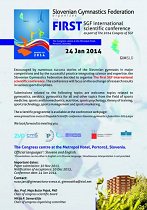
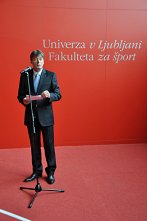

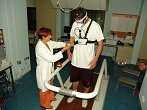


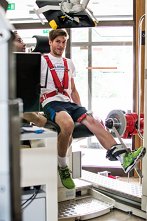

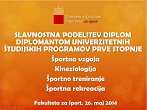



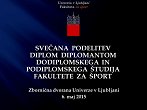


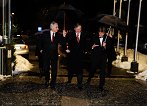










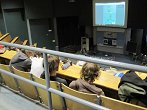
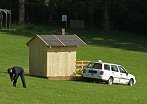


.png)